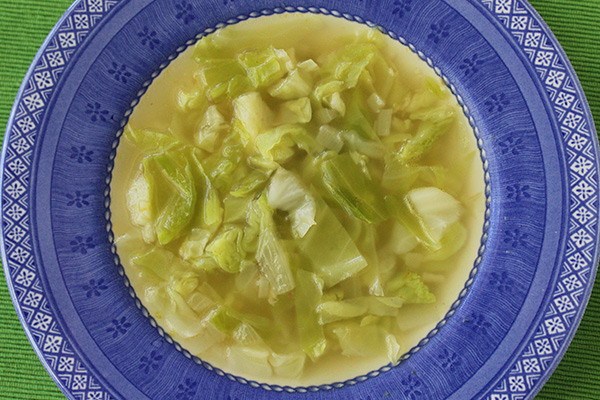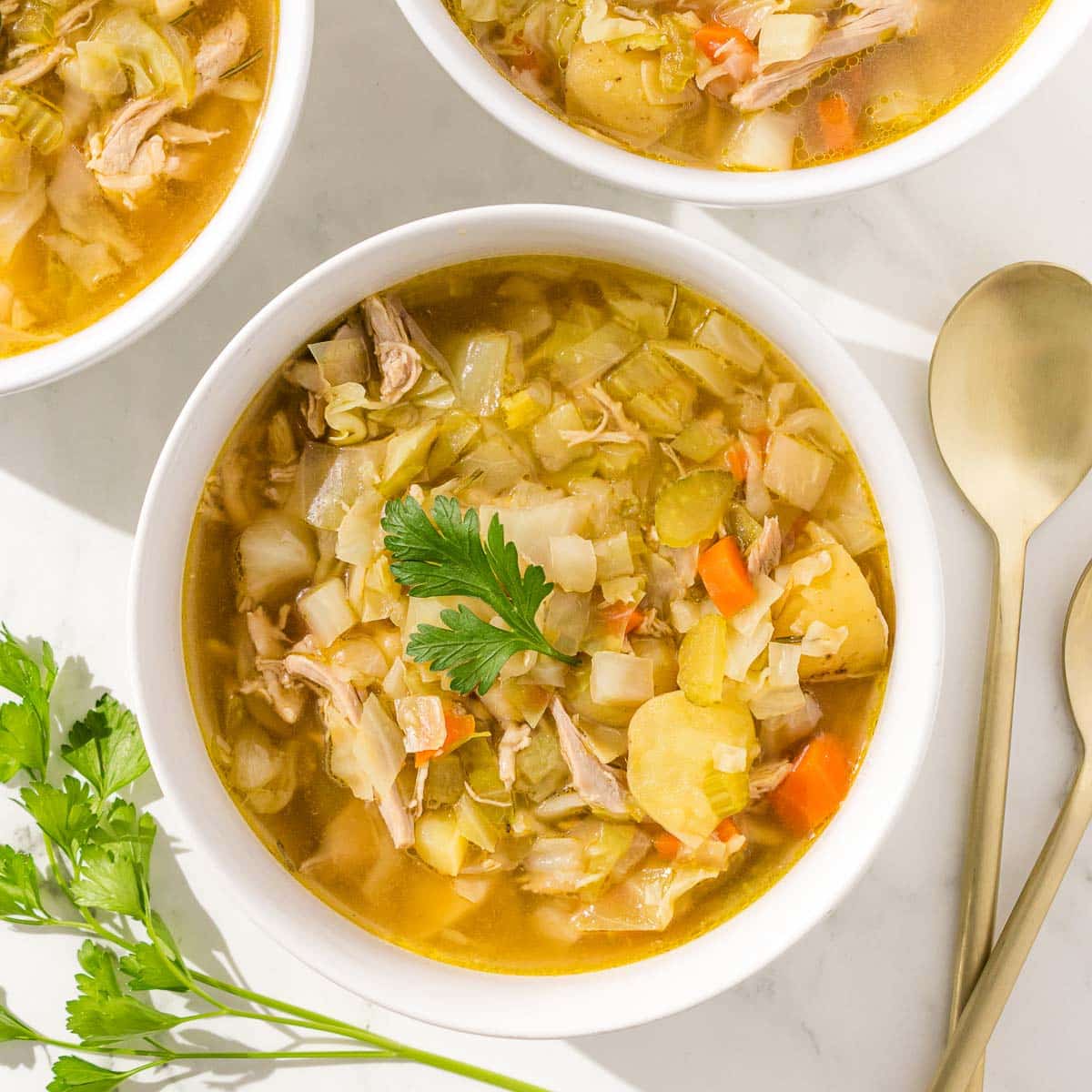A Wholesome Guide to Making Cabbage Soup
Cabbage soup, a simple yet hearty dish, has been a staple in kitchens around the world for generations. Not only is it easy to make, but it’s also incredibly versatile and nutritious. In this comprehensive guide, we’ll walk through the step-by-step process of preparing a delicious cabbage soup that will tantalize your taste buds and warm your soul. From selecting the freshest ingredients to mastering the perfect balance of flavors, let’s embark on a culinary journey together.
Contents
I. Ingredients:
A. Fresh Vegetables:
Cabbage:
Cabbage serves as the star ingredient in this soup, providing a hearty base and a distinctive flavor profile. Opt for fresh, firm heads of cabbage, preferably green or savoy cabbage, for the best results.
Carrots:
Carrots add sweetness and vibrant color to the soup. Look for firm, brightly colored carrots with smooth skin. Freshly harvested carrots tend to have superior flavor and texture.
Celery:
Celery contributes a refreshing crunch and subtle herbal notes to the soup. Choose crisp, bright green celery stalks with compact ribs and fresh leaves for optimal flavor.
Onions:
Onions provide depth of flavor and aromatic richness to the soup base. Yellow or white onions are commonly used, but you can also experiment with sweeter varieties like Vidalia or red onions for a different flavor profile.

B. Additional Flavors:
Garlic:
Garlic adds pungency and complexity to the soup’s flavor profile. Use fresh garlic cloves and mince them finely for even distribution throughout the dish.
Herbs:
Herbs such as thyme, bay leaves, and parsley impart a subtle yet essential herbal essence to the soup. Fresh herbs are preferable for optimal flavor, but dried herbs can also be used if fresh ones are unavailable.
Salt and Pepper:
Salt and pepper are essential for seasoning the soup to taste. Use high-quality sea salt or kosher salt for best results, and freshly ground black pepper for a robust flavor.
Vegetable or Chicken Broth:
Vegetable or chicken broth serves as the liquid base of the soup, infusing it with savory depth and richness. Choose low-sodium varieties if you prefer to control the salt content of the soup.
C. Optional Additions:
Potatoes:
Potatoes add creaminess and heartiness to the soup, making it more filling and satisfying. Choose starchy varieties like russet or Yukon Gold potatoes for their smooth texture when cooked.
Tomatoes:
Tomatoes contribute acidity and sweetness to the soup, complementing the flavors of the other vegetables. Fresh, ripe tomatoes are ideal, but canned diced tomatoes can also be used as a convenient alternative.
Beans:
Beans such as white beans or kidney beans add protein, fiber, and substance to the soup, making it a more substantial meal option. Use canned beans for convenience, or cook dried beans separately before adding them to the soup.
These fresh vegetables and additional flavors form the foundation of a delicious cabbage soup, providing a harmonious blend of textures and tastes that will delight your palate with every spoonful.
II. Preparation:
A. Cleaning and Chopping Vegetables:
Rinse the cabbage under cold water: Start by thoroughly rinsing the cabbage under cold running water. This helps remove any dirt or debris clinging to the leaves.
Remove any outer leaves that appear wilted or damaged: Inspect the cabbage and discard any outer leaves that appear discolored, wilted, or damaged. Ensure that you’re left with fresh, crisp leaves for the best flavor and texture.
Slice the cabbage into thin strips: Using a sharp knife, carefully slice the cabbage into thin strips. Aim for uniformity in thickness to ensure even cooking throughout the soup. You can adjust the width of the strips according to personal preference, keeping in mind that thinner slices will cook more quickly.
Peel and dice carrots and onions: Peel the carrots using a vegetable peeler, then dice them into small, uniform pieces. Similarly, peel the onions, remove the ends, and dice them finely. Uniformly chopped vegetables ensure even cooking and a consistent texture in the finished soup.
Chop celery into small pieces: Trim the ends of the celery stalks and wash them thoroughly. Then, chop the celery into small, bite-sized pieces. Ensure that the pieces are evenly sized to promote uniform cooking and distribution of flavor throughout the soup.
B. Preparing Additional Ingredients:
Mince garlic cloves finely: Peel the garlic cloves and finely mince them using a sharp knife. Mincing the garlic ensures that its flavor disperses evenly throughout the soup, enhancing its overall taste profile. Aim for a fine mince to prevent large chunks of garlic in the finished dish.

Gather herbs and tie them together with kitchen twine: If using fresh herbs such as thyme and parsley, gather them together and tie them into a bundle using kitchen twine. This makes it easier to remove the herbs from the soup once they have infused their flavors, preventing any stray leaves or stems from being left behind in the finished dish.
C. Organizing Workstation:
Set up a large pot or Dutch oven for cooking: Choose a sturdy and spacious pot or Dutch oven to accommodate the volume of soup you intend to prepare. Ensure that the pot has a tight-fitting lid to retain moisture and flavors during the cooking process.
Arrange ingredients in order of use: Before you start cooking, arrange all the prepared ingredients in the order they will be used. This includes chopped vegetables, minced garlic, tied herbs, and any other ingredients required for the recipe. Organizing your workstation in this manner streamlines the cooking process, allowing you to add ingredients seamlessly as you progress through the recipe.
III. Cooking Process:
A. Sautéing Aromatics:
Heat olive oil in the pot over medium heat:
Place your pot or Dutch oven on the stove and heat it over medium heat. Add a drizzle of olive oil, swirling it around to coat the bottom of the pot evenly. Allow the oil to heat up until shimmering but not smoking.
Add diced onions and minced garlic, sautéing until fragrant and translucent:
Once the oil is heated, add the diced onions to the pot, stirring them occasionally with a wooden spoon. Cook the onions for a few minutes until they start to soften and turn translucent.
Add the minced garlic to the pot, stirring it into the onions. Sauté the garlic and onions together until they become fragrant, releasing their aroma. Be careful not to let the garlic burn, as it can turn bitter quickly.
B. Adding Vegetables:
Incorporate carrots and celery into the pot, stirring occasionally until slightly softened:
Add the diced carrots and celery to the pot, stirring them into the onion and garlic mixture. Cook the vegetables for a few minutes until they begin to soften slightly. Stir occasionally to ensure even cooking and prevent sticking.
Introduce sliced cabbage, allowing it to wilt and shrink in volume:
Add the sliced cabbage to the pot, distributing it evenly among the other vegetables. As the cabbage cooks, it will release moisture and start to wilt, reducing in volume. Stir the cabbage occasionally to ensure even cooking and to help it incorporate with the other ingredients.
C. Infusing Flavor:
Pour in vegetable or chicken broth to cover the vegetables adequately:
Once the vegetables have softened slightly, pour in enough vegetable or chicken broth to cover them completely. The broth should submerge the vegetables, providing enough liquid to create a hearty soup base. Adjust the quantity of broth according to your preferred soup consistency.

Add tied herbs bundle, salt, and pepper to taste:
Place the tied herbs bundle into the pot, gently submerging it into the broth. Season the soup with salt and pepper to taste, adding a pinch of each and adjusting as needed. The herbs and seasoning will infuse the soup with depth of flavor, enhancing its overall taste profile.
Bring the soup to a gentle boil, then reduce heat and let it simmer uncovered for about 20-30 minutes, or until vegetables are tender:
Increase the heat to bring the soup to a gentle boil, then reduce it to a simmer. Allow the soup to cook uncovered for about 20-30 minutes, or until the vegetables are tender and fully cooked. Stir the soup occasionally to prevent sticking and to ensure that the flavors meld together beautifully.
By following these steps, you’ll create a delicious cabbage soup that’s bursting with flavor and hearty goodness. Adjust the seasoning to your taste preferences and enjoy the comforting warmth of this wholesome dish.
IV. Adjustments and Customizations:
A. Texture:
For a thicker soup, consider adding diced potatoes or pureeing a portion of the cooked vegetables:
If you prefer a thicker consistency for your cabbage soup, adding diced potatoes is an excellent option. Peel and dice potatoes into small cubes and add them to the soup during the cooking process. As they cook, the potatoes will release starch, thickening the soup naturally. Alternatively, you can ladle out a portion of the cooked vegetables and broth, puree them using a blender or immersion blender, and then return the puree to the pot to create a creamy texture.
To add heartiness, incorporate cooked beans or lentils:
Adding cooked beans or lentils to your cabbage soup enhances its nutritional value and makes it more filling and satisfying. Choose your preferred variety of beans or lentils, such as white beans, kidney beans, or lentils, and add them to the soup during the cooking process. Ensure that the beans or lentils are fully cooked before serving, either by using canned varieties or by cooking them separately and adding them to the soup as desired.
B. Flavor Enhancements:
Experiment with different herbs and spices to tailor the soup to your preferences:
Cabbage soup is incredibly versatile, and you can customize the flavor profile to suit your taste preferences. Experiment with a variety of herbs and spices, such as rosemary, oregano, or paprika, to add depth and complexity to the soup. Consider adding fresh herbs towards the end of the cooking process for a burst of freshness and aroma.
Enhance the flavor profile with a splash of vinegar or a squeeze of lemon juice:
Adding a splash of vinegar, such as apple cider vinegar or balsamic vinegar, or a squeeze of lemon juice can brighten the flavors of the soup and balance its richness. These acidic elements add a tangy note that complements the sweetness of the vegetables and adds depth to the overall taste profile. Start with a small amount and adjust to taste, being careful not to overpower the other flavors in the soup.
C. Dietary Restrictions:
Substitute vegetable broth for chicken broth to make the soup vegetarian or vegan-friendly:
If you follow a vegetarian or vegan diet, you can easily adapt the cabbage soup recipe by substituting vegetable broth for chicken broth. Vegetable broth provides a flavorful alternative that complements the vegetables in the soup without compromising on taste. Choose a high-quality vegetable broth or make your own at home for the freshest flavor.
Adjust seasoning to accommodate dietary restrictions or preferences:
When preparing cabbage soup for individuals with specific dietary restrictions or preferences, such as low sodium or gluten-free diets, it’s essential to adjust the seasoning accordingly. Use low-sodium broth or omit added salt altogether to reduce sodium content. Additionally, check the labels of any packaged herbs or spices to ensure they are gluten-free if needed. Customize the seasoning to suit individual taste preferences, adding more or less as desired while keeping dietary considerations in mind.
By incorporating these adjustments and customizations, you can create a cabbage soup that perfectly suits your taste preferences and dietary needs. Experiment with different ingredients and flavor combinations to discover your favorite variation of this comforting and nourishing dish.
V. Serving and Presentation:
A. Ladle the hot soup into bowls, ensuring each serving contains a generous portion of vegetables and broth:
Once the cabbage soup is fully cooked and infused with delicious flavors, it’s time to serve it up. Using a ladle, carefully portion the hot soup into individual serving bowls. Ensure that each serving contains a generous amount of vegetables, broth, and any optional additions for a satisfying and nourishing meal.
B. Garnish with freshly chopped parsley or a dollop of sour cream for added freshness and creaminess:
Elevate the presentation and flavor of your cabbage soup by adding a final touch of garnish. Sprinkle freshly chopped parsley over each serving to impart a burst of freshness and vibrant color. Alternatively, add a dollop of sour cream or Greek yogurt to the center of each bowl for a creamy and indulgent finish. The garnish not only enhances the visual appeal of the soup but also adds complexity to its taste profile, enhancing your dining experience.
C. Accompany with crusty bread or crackers for dipping and savoring:
To complete the meal, serve your cabbage soup with a side of crusty bread or crackers for dipping and savoring. Choose your favorite type of bread, such as a rustic baguette, artisanal sourdough, or whole grain loaf, and slice it into thick slices or chunks. Alternatively, serve a selection of crackers or breadsticks for added variety and crunch. The bread or crackers provide the perfect accompaniment to the soup, allowing you to soak up the flavorful broth and enjoy every last drop.

By following these serving and presentation suggestions, you’ll create an inviting and satisfying dining experience for yourself and your guests. Whether enjoyed as a comforting meal on a chilly day or as a centerpiece of a gathering with loved ones, your cabbage soup is sure to impress with its delicious flavors and wholesome ingredients.
VI. Storage and Reheating:
A. Allow leftover soup to cool completely before transferring it to airtight containers:
After enjoying your delicious cabbage soup, allow any leftovers to cool to room temperature before storing them. This helps prevent the growth of bacteria and ensures the soup retains its freshness and flavor during storage. Transfer the soup to airtight containers or resealable freezer bags for convenient storage in the refrigerator or freezer.
B. Refrigerate for up to 3-4 days or freeze for longer-term storage:
For short-term storage, refrigerate the leftover cabbage soup in airtight containers for up to 3-4 days. Ensure the containers are properly sealed to prevent the soup from absorbing any unwanted odors or flavors from other foods in the refrigerator.
If you’re not planning to consume the soup within a few days, consider freezing it for longer-term storage. Portion the cooled soup into freezer-safe containers or resealable freezer bags, leaving some room for expansion. Label the containers with the date and contents before placing them in the freezer. Properly stored, cabbage soup can be frozen for up to 3-4 months without significant loss of quality.
C. Reheat gently on the stovetop or in the microwave, adding a splash of water or broth if needed to maintain consistency:
When ready to enjoy the leftover cabbage soup, there are a couple of options for reheating. For stovetop reheating, transfer the desired portion of soup to a saucepan or pot and heat it over medium-low heat, stirring occasionally, until heated through. If the soup has thickened during storage, you may need to add a splash of water or broth to maintain its desired consistency.
Alternatively, you can reheat the soup in the microwave for a quicker option. Transfer the soup to a microwave-safe bowl, cover loosely with a microwave-safe lid or paper towel to prevent splatters, and heat on medium power in one-minute intervals, stirring in between, until heated through.
Regardless of the reheating method you choose, be sure to heat the soup gently to avoid scorching or overheating. Stirring occasionally helps distribute the heat evenly and ensures uniform reheating throughout. Once heated to your desired temperature, ladle the soup into bowls and serve hot, garnishing with additional herbs or toppings if desired.
By following these storage and reheating guidelines, you can enjoy the delicious flavors of your cabbage soup for several days or even weeks to come, ensuring that no leftover soup goes to waste. Whether enjoyed as a quick and satisfying meal or as part of a leisurely dinner, reheated cabbage soup is sure to warm your body and soul with its comforting goodness.
Cabbage soup embodies simplicity and wholesomeness, promising comfort and nourishment. Follow this guide to craft a delicious dish that delights the senses and satisfies the appetite. Enjoy it for any occasion, savoring its hearty flavors and versatility. Gather your ingredients, unleash your creativity, and relish the joy of homemade goodness in every spoonful. Bon appétit
